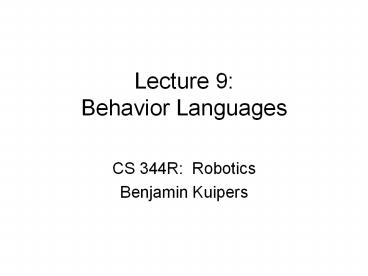Lecture%209:%20Behavior%20Languages - PowerPoint PPT Presentation
Title:
Lecture%209:%20Behavior%20Languages
Description:
The right answer is not completely clear. ... (bumper) (wait T) (atIsection b) ... (Atom (bumper OR atIsection(b)) (go v, )) (Atom (wait T) (goAvoid , kf, kt) ... – PowerPoint PPT presentation
Number of Views:44
Avg rating:3.0/5.0
Title: Lecture%209:%20Behavior%20Languages
1
Lecture 9Behavior Languages
- CS 344R Robotics
- Benjamin Kuipers
2
Alternative Approaches To Sequencers
- Roger Brockett, MDL
- Hristu-Varsakelis Andersson, MDLe.
- Jim Firby, RAPS
- there are others
- The right answer is not completely clear.
3
Motion Description Languages
- Problem Describe continuous motion in a complex
environment as a finite set of symbolic elements. - Applicability sequencing
- Termination condition or time-out.
- Roger Brockett defined MDL.
- Extended to MDLe by Manikonda, Krishnaprasad, and
Hendler.
4
This is an instance ofour framework for control
laws
- A local control law is a triple ?A, Hi, ??
- Applicability predicate A(y)
- Control policy u Hi(y)
- Termination predicate ?(y)
5
The Kinetic State Machine
- The MDLe state evolution model is
- This is an instance of our general model
- There is also
- a set of timers Ti
- a set of boolean features ?i(y)
- U(t, x) is a general control law which can be
suspended by the timer Ti or the interrupt ?i(y)
6
The Kinetic State Machine
7
Q What is the role of G(x)?
- In the state evolution model
- x is in Rn. Motor vector U(t,x) is in Rk.
- G is an n?k matrix whose columns gi are vector
fields in Rn. - Each column represents the effect on x of one
component of the motor vector.
8
MDL Programs
- The simplest MDL program is an atom
- To run an atom,
- apply U to the kinetic state machine model,
- until the interrupt function ?(y) goes false, or
- until T units of time elapse.
9
Compose Atoms to Behaviors
- Given atoms
- Define the behavior
- Which means to do the atoms sequentially until
the interrupt ?b or time-out Tb occurs. - Behaviors nest recursively to make plans.
10
Example Interrupts
- (bumper)
- (wait T)
- (atIsection b)
- b specifies 4 bits whether obstacle is required
(front, left, back, right). - Interrupt occurs when a location of that
structure is detected.
11
Example Atoms
- (Atom interrupt_condition control_law)
- (Atom (wait ?) (rotate ?))
- (Atom (bumper OR atIsection(b)) (go v, ?))
- (Atom (wait T) (goAvoid ?, kf, kt))
- (Atom (ri(t)rj(t)) (align ri rj))
- Select ideas from here for your controllers.
12
Environment Model
- A graph of local maps.
- We will study local metrical maps later.
- Likewise topological maps.
- Edges in the graph represent behaviors.
- Compact and effective
- Local metrical maps are reliable.
- Describe geometry only where necessary.
13
Experiment
- They built a model of three places in their
laboratory. - They demonstrated MDLe plans for travel between
pairs of places.
14
Limitations
- Simple sequential FSM model.
- No parallelism or combination of control laws.
- No success/failure exits from control laws.
- Much can pack into the interrupt conditions.
- Limited evaluation
- No exploration or learning.
- No test of reliability.
15
Next Observers
- Probabilistic estimates of the true state, given
the observations. - Basic concepts
- Probability distribution Gaussian model
- Expectations
16
Estimates and Uncertainty
- Conditional probability density function
17
Gaussian (Normal) Distribution
- Completely described by N(?,?)
- Mean ?
- Standard deviation ?, variance ? 2
18
The Central Limit Theorem
- The sum of many random variables
- with the same mean, but
- with arbitrary conditional density functions,
- converges to a Gaussian density function.
- If a model omits many small unmodeled effects,
then the resulting error should converge to a
Gaussian density function.
19
Expectations
- Let x be a random variable.
- The expected value Ex is the mean
- The probability-weighted mean of all possible
values. The sample mean approaches it. - Expected value of a vector x is by component.
20
Variance and Covariance
- The variance is E (x-Ex)2
- Covariance matrix is E (x-Ex)(x-Ex)T
21
Covariance Matrix
- Along the diagonal, Cii are variances.
- Off-diagonal Cij are essentially correlations.
22
Independent Variation
- x and y are Gaussian random variables (N100)
- Generated with ?x1 ?y3
- Covariance matrix
23
Dependent Variation
- c and d are random variables.
- Generated with cxy dx-y
- Covariance matrix































